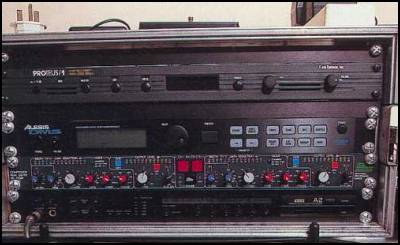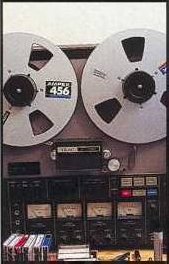
DSS compressor, Korg A2 digital f/x processor.
KM: Can you tell us about the things in the rack as well?
DG: From the bottom, first it's the Korg A2, mainly used for guitars.
The one above it is the BSS stereo compressor DPR402, which is a must for anyone who wants to make home demos.
It's an excellent digital compressor and includes a De-Esser, which I've never used.
I always run my multi-track through it when mixing, it adds a lot of magic to a mix.


The one above that is an Alesis DM5 -- the fantastic drum module that Andy Partridge is using. I've just bought one for myself; it replaces my Alesis HR-16. Also there's the EMU Proteus/1, to which I've added the Proteus/2 orchestra board. (Note: This has now been replaced by the EMU e6400 sampler)
I bought a Lexicon LXP-1 in 1991. It has wonderful quality. I thought it was a little noisy, but then I discovered that the power supply was too close to it (laughs). Of course, I sometimes use the A2's reverb as well.
As for the recording equipment, I use Seck 12/8/2 as the console and the Fostex R-8 recorder. The monitor speakers are Gold, made by an English company called JPW. I still use an analogue tape recorder, and the R-8 is a fantastic machine.
I also think that if I make perfect demos at home, I cannot develop them any further with the other members in the studio, although Andy uses the ADAT to create studio-quality demos.
I used to make demos with a TEAC 3440, which was an excellent machine as well. That was a 4-track machine, so it had the advantage of generating less noise compared with an 8-track machine. The TEAC didn't have noise reduction. You can just about get along without it if you run 4 tracks at 15 IPS. I've never liked noise reduction on cassettes particularly, you can lose more than just noise. (Note: I've since revised my opinion about noise reduction on multi-tracks!)
KM: You are also known to record Beatles' songs at home.
Are you influenced by their compressed keyboard sounds?
DG: I think every sound recorded in Abbey Road Studios in the '60s was compressed.
Great sounds were created by Fairchild's vacuum tube compressor.
I believe you can still buy them, however they're very scarce and expensive.
But they can create a fantastic effect.
I was working at Abbey Road in the summer of 1996 on Mark Owen's record, and they still had two pianos there the Beatles had used in Studio 2. One is the Steinway upright that John Lennon was photographed at teaching "All You Need Is Love" to the band. If you play a big E major chord on it, you're right in at the end of "A Day In The Life"! When you play in that studio, because of the natural acoustics, you get a sound that you can never get in any other studio. Whether it's a keyboard or a drum, you can get a sound that you won't find anywhere else. There's magic in that room.
| <<< previous | 1 · 2 · 3 · 4 | next >>> |